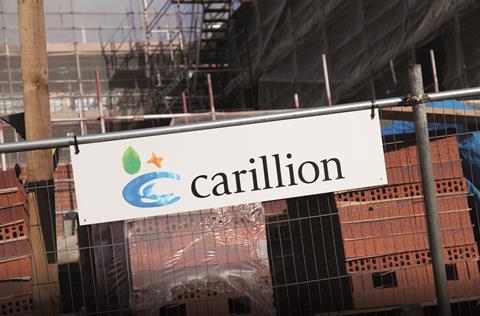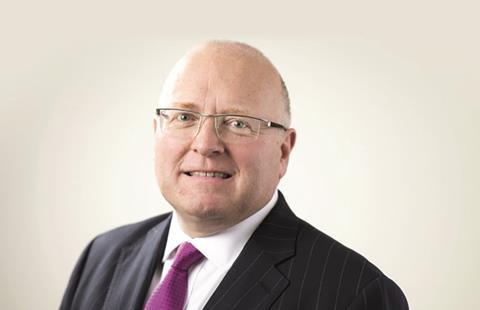Haemorrhaging both money and management, CarillionÔÇÖs position evokes that of now-healthy Balfour Beatty three years back. What lessons can Carillion learn from BalfourÔÇÖs recovery, and can it pull off the same trick?

Contractor CarillionÔÇÖs interim results, published late last month, revealed a business in even worse shape than previously admitted, with a further ┬ú200m of revenue written off for poorly performing contracts, this time in the previously unstained support services side of the business.
In total Carillion has since July written down the best part of ┬ú1.2bn for this year, falling to a six-month loss of ┬ú1.15bn. Analysts duly upped their estimates of the cash needed to fix the ailing contractorÔÇÖs balance sheet, with finance specialist Liberum estimating that as much as ┬ú800m may now be needed. The firm is now in the perilous position of its liabilities outweighing the assets on its balance sheet to the tune of ┬ú405m.
But amid the deepening pain and promises of reform and restructure, there were two significant pieces of good news: first, that it clearly sees a route to reducing its pension fund liability by up to ┬ú200m; and, even more importantly, that its lenders have agreed to give it extra banking headroom to the tune of ┬ú140m. Analysts and peers say this is a sign CarillionÔÇÖs backers will give it enough time to fix its financial problems because the alternative, cutting it loose, is so much worse. Joe Brent, analyst at Liberum, says the new facility is likely to be ÔÇťmore an act of self-preservation than generosityÔÇŁ on the part of the banks, adding: ÔÇťWe expect that the banks are firmly in control of the business.ÔÇŁ
The chief executive of a rival listed contractor says: ÔÇťIf it was a small business, it would be bust by now ÔÇô but as it is, itÔÇÖs too important to everyone to continue. The banks clearly support it, and the government supports it too.ÔÇŁ
So, if Carillion is to be given a chance to mend its ways, what are the chances it can pull off a successful restructuring? Announcing the recent results, interim chief executive Keith Cochrane told analysts that turning the business around will take between three and five years. ÔÇťAt the heart of this business is a strong core,ÔÇŁ he said. ÔÇťSupported by an operating model that manages risk much more effectively, and led by a fresh management team with a mandate to drive cultural change, a solid business can emerge the other side. But it will not be a quick fix.ÔÇŁ

Just three years ago the only UK construction business bigger than Carillion, Balfour Beatty, was itself in dire straits. Hundreds of millions of pounds of writedowns had prompted, as with Carillion, the departure of much of its senior leadership, and analysts were questioning whether it could carry on as the dominant UK player that it had been.
But today Balfour Beatty has not only returned to profitability, it has seen its revenue start to rise again and its share price climb to 70% above its 2014 low. While the recovery programme is not yet complete at Balfour Beatty, what similarities are there with the situation at Carillion, and what lessons can Carillion learn from its turnaround? Here ║├╔ź¤╚╔˙TV considers the lessons in four areas that will be essential for determining CarillionÔÇÖs future.
ÔÇťBalfour Beatty had by this equivalent stage achieved a far more dynamic change of management. They had someone in place that could start to get them out of itÔÇŁ
Kevin Cammack, Cenkos
Lesson #1 - refinancing
CarillionÔÇÖs balance sheet challenge is enormous, and itÔÇÖs here that the contrast is starkest with the position of Balfour Beatty at its nadir. Where CarillionÔÇÖs net debt is predicted to peak at more than ┬ú1bn in the first half of next year, Balfour Beatty, even during its darkest times, had a ┬ú1bn portfolio of operational PPP contracts to prop up its balance sheet and no net debt. While Balfour warned at one stage that it could get close to breaching banking covenants, the ┬ú234m sale of consultant Parsons Brinckerhoff was enough to head off any risk of that eventuality.
Cenkos analyst Kevin Cammack says: ÔÇťThe massive difference is that Balfour Beatty had something to put on the balance sheet: ┬ú1bn of tangible assets that meant its balance sheet was never under the stress CarillionÔÇÖs is now.ÔÇŁ John Frankiewicz, the former chief executive of Willmott DixonÔÇÖs construction arm, says: ÔÇťCarillionÔÇÖs challenge looks to be on a greater scale than anything seen by the industry in the last 30 years.ÔÇŁ
While Carillion interim chief Keith Cochrane has said the firm is forecast to comply with banking covenants up until at least June 2018, analysts say having a net debt that is more than four times its operating profit (known as Ebitda) is unsustainable. At the interim results, Cochrane said the business was looking to get this ratio down to at least 1.5 (meaning net debt of no more than 1.5 times Ebitda). He said fixing the balance sheet was a key priority, and also admitted for the first time that to do this the business would ÔÇťconsiderÔÇŁ an injection of equity to ÔÇťrepair and rebuild the balance sheet in due courseÔÇŁ. While Carillion says it can raise ┬ú300m in the short term by selling off parts of its business, analysts estimate that requirement for new investment at anything between ┬ú440m and ┬ú800m.
ÔÇťThis is a really, really tough gig for whoever takes it on ÔÇô there are so many people to keep happyÔÇŁ
Chief executive of rival contractor
The big problem for Carillion ÔÇô and its banks and shareholders ÔÇô is how to raise that cash. While listed companies can use the stock exchange, CarillionÔÇÖs stock market valuation ÔÇô just ┬ú200m ÔÇô means that raising even ┬ú400m would dilute the value of existing shares by 60%. Sam Cullen, equity analyst at Jefferies, says: ÔÇťItÔÇÖs clearly a big ask for shareholders to raise that.
I guess CarillionÔÇÖs thinking is that if they make some progress on cost reductions and disposals, the shares re-rate and the ratio of the required raise to market capitalisation comes down.ÔÇŁ
CenkosÔÇÖs Cammack says the scale means Carillion is also likely to ask its lenders to accept the conversion of some of their debt into equity ÔÇô which would again require them to take some losses.
There is another big obstacle to this: CarillionÔÇÖs ┬ú587m pension fund deficit. Without prior agreement with the pension fund trustees to reduce this deficit, the fund would automatically take any cash raised to plug this hole. Stephen Rawlinson, analyst at Applied Value, says: ÔÇťThe real block on raising new equity is the pension deficit. As it is, the fund would be legally obliged to grab the money raised. Any deal with the pension fund would require approval from the regulator, and the pace of this is glacial.ÔÇŁ

Lesson #2 - leadership
Carillion has undergone significant change in leadership in the past year as its problems have emerged. In that period, the business has seen the departure of chief executive Richard Howson, as well as two group finance directors, the managing directors of both the construction and services businesses, the UK buildings boss and three more divisional finance directors. Former non-executive director Keith Cochrane is the interim chief executive until a full-time replacement is found. Other senior roles are being filled by secondees, such as Lee Watson (from consultant EY) as chief transformation officer.
While Balfour Beatty, in comparison, had a similar period of leadership uncertainty ÔÇô at one point both its chief executive and chair had resigned ÔÇô the fact that its problems emerged gradually meant it was able to get replacements in time to oversee the recovery. The appointment of Leo Quinn, an experienced plc leader trusted by investors, happened while the full extent of BalfourÔÇÖs problems was still emerging, enabling him to set a strategy for recovery. Kevin Cammack, analyst at Cenkos, says: ÔÇťBalfour Beatty had by this equivalent stage achieved a far more dynamic change of management. They had someone in place that could start to get them out of it.ÔÇŁ
This is important because the firmÔÇÖs lenders and shareholders are likely to want to know who the long-term boss of the business will be before agreeing to inject further money to refinance it. Cammack says: ÔÇťIs a refinancing even possible without the CEO position filled?ÔÇŁ
At the interim results announcement, Carillion chair Philip Green reported ÔÇťgood progressÔÇŁ on the search for a new chief executive, but gave no indication of when an appointment would be made. The chief executive of a rival listed contractor says: ÔÇťTheyÔÇÖre going to have to find a heavy hitter from outside the industry. This is a really, really tough gig for whoever takes it on ÔÇô there are so many people to keep happy: shareholders, banks, bondsmen, the board, staff, and clients.ÔÇŁ

Lesson #3 - restructuring
Balance sheet aside, many of the problems Carillion is facing are similar to those experienced by Balfour ÔÇô a historic lack of control over bidding, leading to jobs taken at too low margins or too high risks, and problems with the execution of contracts and recovery of money where things have gone wrong. Speaking at the interims, chief executive Keith Cochrane, while saluting his front-line staff, was brutal in his assessment. He talked of an ÔÇťover-inflated group overheadÔÇŁ, a ÔÇťcomplete lack of line of sight accountabilityÔÇŁ, and a ÔÇťa high degree of uncertainty over key assumptionsÔÇŁ, which combined with rapid growth and problem contracts to create a ÔÇťperfect stormÔÇŁ. He said: ÔÇťChecks and balances in the business across vital areas such as bid management, mobilisation, margin, cash and claims have not been consistently where they should be.ÔÇŁ
ÔÇťThey seem to be saying they can reduce their activity and it wonÔÇÖt reduce their cash. Well, they must have a secret recipe that no one else knows aboutÔÇŁ
Chief executive of rival contractor
As such, CochraneÔÇÖs proposed restructure of CarillionÔÇÖs operational business highlights similar priorities to Leo QuinnÔÇÖs Build to Last programme at Balfour. This aimed to bring ┬ú200m of cash in and cut ┬ú100m of cost out of the business, while strengthening central financial controls. Meeting these targets in QuinnÔÇÖs second year went some way to steadying investorsÔÇÖ nerves.
CochraneÔÇÖs blueprint at Carillion is to rationalise the business by reducing management duplication and cutting ┬ú75m of costs from the firmÔÇÖs central overhead. Meanwhile, he is aiming to exert greater control over cash, bidding and claims by instituting ÔÇťcentres of excellenceÔÇŁ in these areas that have the power to overrule business unit decisions. Jefferies analyst Sam Cullen says: ÔÇťThe group has outlined a familiar-sounding turnaround plan, with a renewed focus on [its] core UK activities, a more pragmatic bidding framework and an increased focus on cash collection.ÔÇŁ While Cenkos analyst Kevin Cammack says the plan overall is ÔÇťsensibleÔÇŁ, LiberumÔÇÖs Joe Brent calls the scale of cost-cutting ÔÇťextremely boldÔÇŁ.
However, CochraneÔÇÖs self-help plan also involves shrinking the business, from nearly ┬ú5bn turnover currently, to ┬ú3bn-3.5bn in future, by being much more selective about the contracts it bids for. This runs the risk of sucking further cash out of the business, as old contracts are not replaced by upfront payments for new ones, and thereby worsening the balance sheet position.
A rival contractor chief executive says: ÔÇťThey seem to be saying they can reduce their activity and it wonÔÇÖt reduce their cash. Well, they must have a secret recipe that no one else knows about.ÔÇŁ Meanwhile, the restructuring will actually cost more in cash next year (┬ú60m) than it saves (┬ú50m).
Lesson #4 - winning work
While Carillion is planning to scale down the business overall ÔÇô including cutting the ┬ú1.5bn turnover of its construction business by more than 50% ÔÇô it will still need to keep winning work, and at better margins, if it is to recover. Balfour Beatty does appear to have managed this, with recent wins on HS2, and its latest interims (to June this year) showing revenue up nearly 10% on 2016. Carillion, too, has reported significant project wins since it revealed its financial woes in July, with both HS2 and the Defence Infrastructure Organisation awarding it significant contracts. Carillion chief Keith Cochrane told analysts: ÔÇťSince the end of June weÔÇÖve continued to win work on prestigious projects.ÔÇŁ
While these big public contracts have come through, the confidence of private sector clients in awarding the firm large contracts is unclear. Cenkos analyst Kevin Cammack says: ÔÇťIn the public sector thereÔÇÖs almost a duty to support it. They donÔÇÖt want to see it go to the wall, with all the repercussions that would have.
ÔÇťIn the public sector thereÔÇÖs almost a duty to support it. they donÔÇÖt want to see it go to the wall, with all the repercussions that would haveÔÇŁ
Kevin Cammack, Cenkos
ÔÇťBut if I were a private sector client choosing between three or four different firms, I think IÔÇÖd just put a red line through Carillion right now,ÔÇŁ he says, adding this view is not based on fears of it going bust but rather on a concern whether key staff will stay long enough to see the job through. Simon Rawlinson of Applied Value says customers are ÔÇťrightly nervousÔÇŁ but that Carillion has been attempting to ÔÇťmake them feel comfortableÔÇŁ.
Potential clients and supply chain partners paying close attention may also be put off by some of the rhetoric coming out of the firm. Announcing his plan to create a centre of excellence for claims management, Cochrane said one of CarillionÔÇÖs mistakes had been to ÔÇťnot pursue claims aggressively enoughÔÇŁ and that an overly generous approach to clients would change. On big FM contracts he said Carillion had: ÔÇťburned cash, through a desire do the best thing by customers, without properly assessing what is right for Carillion from a commercial perspective.ÔÇŁ
Rudi Klein, chief executive of the Specialist Engineering ContractorsÔÇÖ Group, says he has already heard reports of Carillion increasingly disputing bills. He says the contractor should be forced to use project bank accounts on all public sector contracts to protect suppliers from a default. One supplier told ║├╔ź¤╚╔˙TV it is now holding out for better terms and conditions on contracts with Carillion, in order to offset the fear the contractor will in future pursue claims more aggressively.
A spokesperson for Carillion said: ÔÇťWe value the close relationship we have with our suppliers and we continue to be committed to business as usual with all of our partners and suppliers, including adherence to all payments terms.ÔÇŁ

Formerly deputy editor at ║├╔ź¤╚╔˙TV magazine, Joey has worked as a journalist in the sector for nearly two decades.
He currently has a special focus on the Housing Today publication, helping it deliver razor sharp news, analysis and insight.View full Profile






























No comments yet